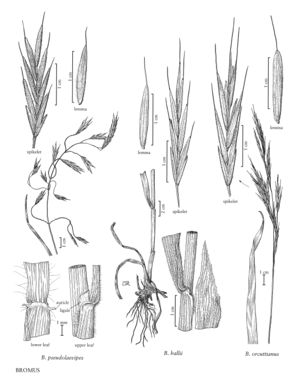Difference between revisions of "Bromus pseudolaevipes"
FNA>Volume Importer |
FNA>Volume Importer |
||
| Line 38: | Line 38: | ||
|publication year= | |publication year= | ||
|special status= | |special status= | ||
| − | |source xml=https://jpend@bitbucket.org/aafc-mbb/fna-data-curation.git/src/ | + | |source xml=https://jpend@bitbucket.org/aafc-mbb/fna-data-curation.git/src/f6b125a955440c0872999024f038d74684f65921/coarse_grained_fna_xml/V24/V24_293.xml |
|subfamily=Poaceae subfam. Pooideae | |subfamily=Poaceae subfam. Pooideae | ||
|tribe=Poaceae tribe Bromeae | |tribe=Poaceae tribe Bromeae | ||
Revision as of 19:15, 24 September 2019
Plants perennial; not rhizomatous. Culms 60-120 cm, erect or spreading; nodes 4-6, pubescent or puberulent; internodes mostly glabrous, sometimes pubescent to puberulent just below the nodes. Sheaths glabrous or pilose, often pilose near the auricles; auricles usually present on the lower leaves, rarely absent; ligules to 1.5 mm, usually pubescent, sometimes glabrous, truncate to obtuse, laciniate, ciliolate; blades 10-25 cm long, 3-9 mm wide, flat, glabrous, pilose on the margins or throughout. Panicles 10-20 cm, open, usually nodding; branches ascending to spreading or reflexed. Spikelets 15-35 mm, elliptic to lanceolate, terete to moderately laterally compressed, with 4-10 florets. Glumes usually pubescent, rarely glabrous, sometimes scabrous, margins often bronze-tinged; lower glumes 4-7 mm, 3-veined; upper glumes 6.5-9 mm, (3)5-veined; lemmas 10-13 mm, elliptic to lanceolate, rounded over the midvein, backs usually pubescent, sometimes glabrous distally, margins often bronze-tinged, pubescent nearly throughout, apices acute to obtuse, entire, rarely slightly emarginate, lobes shorter than 1 mm; awns 3-5 mm, straight, arising less than 1.5 mm below the lemma apices; anthers 3.5-5 mm. 2n = 14.
Discussion
Bromus pseudolaevipes grows in dry, shaded or semishaded sites in chaparral, coastal sage scrub, and woodland-savannah zones, from near sea level to about 900 m, in central and southern California. It is not known from Mexico.
Selected References
None.
